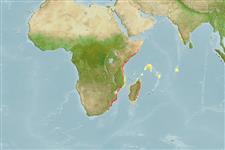>
Perciformes/Uranoscopoidei (Sand dwellers) >
Pinguipedidae (Sandperches)
Etymology: Parapercis: Greek, para = the side of + Greek, perke = perch (Ref. 45335); albiventer: Name from Latin 'albiventer' meaning white ventral surface, referring to the bright white immaculate color on ventral fourth of the body..
Environment: milieu / climate zone / depth range / distribution range
Écologie
marin; profondeur 18 - 31 m (Ref. 95986). Tropical
Western Indian Ocean: Madagascar, southern Mozambique and South Africa; including Zanzibar.
Taille / Poids / Âge
Maturity: Lm ? range ? - ? cm
Max length : 16.8 cm SL mâle / non sexé; (Ref. 95986); 15.9 cm (female)
Description synthétique
Morphologie | Morphométrie
Épines dorsales (Total): 5; Rayons mous dorsaux (Total): 21; Épines anales 1; Rayons mous anaux: 17; Vertèbres: 30. This species is distinguished by the following characters: a bright white ventral surface, without color markings on lower fourth of body; a row of 10 reddish blotches present at vertical through lower half of pectoral-fin base, the lower part of each blotch with a solid black bar ventrally. Further distinguished from its congeners by having the following characters: D V,21; A I,17; pectoral-fin rays 17-18 (mainly 17); front of lower jaw with 3 pairs of enlarged canines; pored lateral line scales 55-59 (mainly 58); total gill rakers 16-19; and a different coloration (having 3 pairs of dark broad bands on upper lip; curved black band on front of underside of chin; medium-sized orange-red irregular spots on entire dorsal surface of head; small irregular spots densely covering nape and dorsal surface of body; row of faint red blotches, on paler background, along body axis; caudal fin with two black longitudinally elongate bars on anterior half, black spots on upper and lower thirds, central third of posterior) (Ref. 95986).
Life cycle and mating behavior
Maturité | Reproduction | Frai | Œufs | Fécondité | Larves
Ho, H.-C., P.C. Heemstra and H. Imamura, 2014. A new species of the sandperch genus Parapercis from the western Indian Ocean (Perciformes: Pinguipedidae). Zootaxa 3802(3):335-345. (Ref. 95986)
Statut dans la liste rouge de l'IUCN (Ref. 130435)
Menace pour l'homme
Harmless
Utilisations par l'homme
Plus d'informations
PaysZones FAOÉcosystèmesOccurrencesIntroductionsStocksÉcologieRégime alimentaireÉléments du régime alimentaireConsommation alimentaireRation
Noms communsSynonymesMétabolismePrédateursÉcotoxicologieReproductionMaturitéFraiRassemblement de ponteFéconditéŒufsDéveloppement de l'œuf
Taille/ÂgeCroissanceLongueur-poidsLongueur-longueurFréquences de longueursMorphométrieMorphologieLarvesDynamique des populations larvairesRecrutementAbondanceBRUVS
RéférencesAquacultureProfil d'aquacultureSouchesGénétiqueElectrophoresesHéritabilitéPathologiesTraitementNutrientsMass conversion
CollaborateursImagesStamps, Coins Misc.SonsCiguateraVitesseType de nageSurface branchialeOtolithesCerveauxVision
Outils
Articles particuliers
Télécharger en XML
Sources Internet
Estimates based on models
Preferred temperature (Ref.
123201): 24.9 - 27.4, mean 26.8 °C (based on 16 cells).
Phylogenetic diversity index (Ref.
82804): PD
50 = 0.5000 [Uniqueness, from 0.5 = low to 2.0 = high].
Bayesian length-weight: a=0.00692 (0.00311 - 0.01538), b=3.06 (2.88 - 3.24), in cm total length, based on LWR estimates for this Genus-body shape (Ref.
93245).
Niveau trophique (Ref.
69278): 3.5 ±0.4 se; based on size and trophs of closest relatives
Résilience (Ref.
120179): Haut, temps minimum de doublement de population inférieur à 15 mois (Preliminary K or Fecundity.).
Fishing Vulnerability (Ref.
59153): Low vulnerability (10 of 100).
